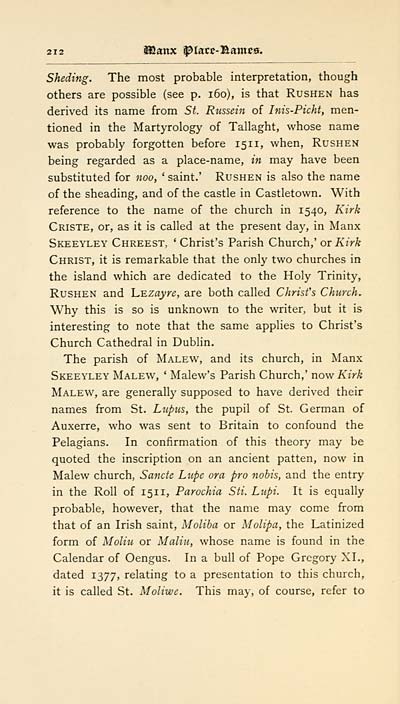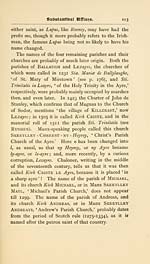Download files
Complete book:
Individual page:
Thumbnail gallery: Grid view | List view

Manx ^lacc-Bamca.
Sheding. The most probable interpretation, though
others are possible (see p. i6o), is that Rushen has
derived its name from St. Rtissein of hiis-Picht, men-
tioned in the Martyrology of Tallaght, whose name
was probably forgotten before 1511, when, Rushen
being regarded as a place-name, in may have been
substituted for noo, ' saint.' Rushen is also the name
of the sheading, and of the castle in Castletown. With
reference to the name of the church in 1540, Kirk
Criste, or, as it is called at the present day, in Manx
Skeeyley Chreest, ' Christ's Parish Church,' or Kirk
Christ, it is remarkable that the only two churches in
the island which are dedicated to the Holy Trinity,
Rushen and 'L'EZayre, are both called Christ's Church.
Why this is so is unknown to the writer, but it is
interesting to note that the same applies to Christ's
Church Cathedral in Dublin.
The parish of Malew, and its church, in Manx
Skeeyley Malew, ' Malew's Parish Church,' now Kirk
Malew, are generally supposed to have derived their
names from St. Ltipiis, the pupil of St. German of
Auxerre, who was sent to Britain to confound the
Pelagians. In confirmation of this theory may be
quoted the inscription on an ancient patten, now in
Malew church, Sancte Ltipe ora pro nobis, and the entry
in the Roll of 151 1, Parochia Sti. Ltipi. It is equally
probable, however, that the name may come from
that of an Irish saint, Moliba or Molipa, the Latinized
form of Moliu or Maliu, whose name is found in the
Calendar of Oengus. In a bull of Pope Gregory XL,
dated 1377, relating to a presentation to this church,
it is called St. Moliwe. This may, of course, refer to
Sheding. The most probable interpretation, though
others are possible (see p. i6o), is that Rushen has
derived its name from St. Rtissein of hiis-Picht, men-
tioned in the Martyrology of Tallaght, whose name
was probably forgotten before 1511, when, Rushen
being regarded as a place-name, in may have been
substituted for noo, ' saint.' Rushen is also the name
of the sheading, and of the castle in Castletown. With
reference to the name of the church in 1540, Kirk
Criste, or, as it is called at the present day, in Manx
Skeeyley Chreest, ' Christ's Parish Church,' or Kirk
Christ, it is remarkable that the only two churches in
the island which are dedicated to the Holy Trinity,
Rushen and 'L'EZayre, are both called Christ's Church.
Why this is so is unknown to the writer, but it is
interesting to note that the same applies to Christ's
Church Cathedral in Dublin.
The parish of Malew, and its church, in Manx
Skeeyley Malew, ' Malew's Parish Church,' now Kirk
Malew, are generally supposed to have derived their
names from St. Ltipiis, the pupil of St. German of
Auxerre, who was sent to Britain to confound the
Pelagians. In confirmation of this theory may be
quoted the inscription on an ancient patten, now in
Malew church, Sancte Ltipe ora pro nobis, and the entry
in the Roll of 151 1, Parochia Sti. Ltipi. It is equally
probable, however, that the name may come from
that of an Irish saint, Moliba or Molipa, the Latinized
form of Moliu or Maliu, whose name is found in the
Calendar of Oengus. In a bull of Pope Gregory XL,
dated 1377, relating to a presentation to this church,
it is called St. Moliwe. This may, of course, refer to
Set display mode to: Large image | Transcription
Images and transcriptions on this page, including medium image downloads, may be used under the Creative Commons Attribution 4.0 International Licence unless otherwise stated. ![]()
| Early Gaelic Book Collections > Blair Collection > Surnames & place-names of the Isle of Man > (230) |
|---|
| Permanent URL | https://digital.nls.uk/82102408 |
|---|
| Description | A selection of books from a collection of more than 500 titles, mostly on religious and literary topics. Also includes some material dealing with other Celtic languages and societies. Collection created towards the end of the 19th century by Lady Evelyn Stewart Murray. |
|---|
| Description | Selected items from five 'Special and Named Printed Collections'. Includes books in Gaelic and other Celtic languages, works about the Gaels, their languages, literature, culture and history. |
|---|

